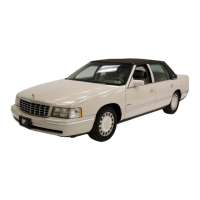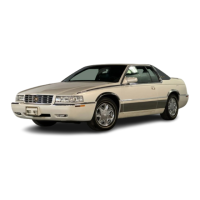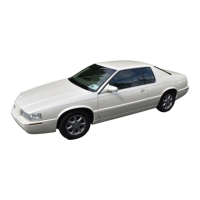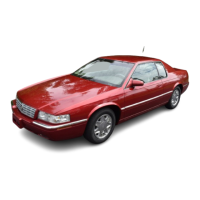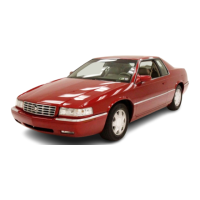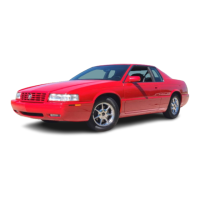Do you have a question about the Cadillac 1997 Eldorado and is the answer not in the manual?
Adjusting power seat controls for front seats, including cushion and seatback adjustments.
Explains the importance and proper use of safety belts for all occupants.
Detailed instructions on wearing lap-shoulder belts correctly for adults and children.
Guidance on safe and proper safety belt use for pregnant women.
Information on the correct position for the front passenger, similar to the driver's.
Explains the function and operation of the vehicle's air bag system.
Emphasizes the importance of buckling up for rear seat passengers.
General information on child protection and vehicle restraint laws.
Guidelines for using child or infant restraints and why they are safer.
Instructions for using a safety belt extender if the standard belt is too short.
How to inspect safety belts, buckles, and other restraint system parts for proper function.
When and how to replace safety belts or other restraint components after a collision.
Describes the function of the square ignition key and oval door key.
Explains how to lock and unlock the vehicle using the door key or RKE transmitter.
Details the functions of the RKE transmitter for locking, unlocking, and operating the vehicle.
Explains how the theft-deterrent system arms, activates, and how to avoid false alarms.
Explains how the theft-deterrent system arms, activates, and how to avoid false alarms.
Describes the PASS-Key II theft-deterrent system and its operation with the ignition key.
Guidelines for breaking in a new vehicle for optimal long-term performance.
Explains the five different positions of the ignition switch and their functions.
Step-by-step instructions on how to start the vehicle's engine safely and properly.
Information on the engine coolant heater option and its usage.
Details the different gear positions and safe operation of the automatic transaxle.
Instructions on how to set and release the parking brake and its indicator light.
Procedures for safely shifting into PARK, including using the parking brake.
Steps required to shift the vehicle out of PARK when the ignition is in RUN.
Warning about parking near combustible materials that could ignite.
Information about potential exhaust leaks and carbon monoxide hazards.
Tips and precautions for running the engine while the vehicle is parked.
Operation of power windows, including the express-down feature and retained accessory power.
How to use the turn signal lever for turns, lane changes, and headlamp functions.
Information on controlling exterior lamps like headlamps, parking lamps, and fog lamps.
Operation of interior lamps, including courtesy lamps and instrument panel lighting.
Operation and features of electrochromic day/night rearview and auto-dimming outside mirrors.
Locations and usage of various storage areas like the glove box and overhead console.
Location and usage of the ashtrays and cigarette lighter.
Information on the optional cellular telephone system and its features.
Description of assist handles located on the side pillars for easier entry/exit.
Information about garment hooks attached to assist handles for convenience.
Care instructions for the vehicle's rubber-backed front and rear floor mats.
Operation of the power glass panel and sunshade for the astroroof.
How to program and use the universal transmitter for garage doors and other devices.
Overview of the instrument panel components and their functions as an information system.
Explanation of the digital instrument cluster display and its controls.
Description of the analog instrument cluster gauges and indicators.
Explains the meaning of various warning lights, gages, and indicators on the instrument panel.
How the DIC displays vehicle system status, personalization features, and warning messages.
Overview of the Electronic Climate Control (ECC) system for managing comfort in the vehicle.
Explanation of the climate control panel buttons and knobs for fan speed and temperature.
How the solar sensor monitors sunlight to automatically adjust cabin temperature.
Operation of the air conditioning system for cooling and dehumidifying the cabin air.
How to use the heater system to adjust interior temperature and airflow.
Operation of the flow-through ventilation system for supplying outside air.
Instructions on using the defrost function to clear fog or ice from the windshield.
How to operate the rear window defogger and heated outside mirrors.
Using steering wheel controls to adjust heating, cooling, and fan speed.
How climate control settings can be recalled via RKE transmitter or memory seat buttons.
Overview of the vehicle's audio system and how to operate its controls for optimal enjoyment.
Step-by-step instructions for setting the vehicle's clock to the correct time.
Operation of the AM-FM stereo, cassette player, and optional CD player functions.
Detailed operation of the Bose audio system, including DSP features.
Instructions for loading and playing discs in the trunk-mounted CD changer.
How the vehicle recalls previous radio settings based on RKE transmitter or driver preference.
Automatic theft-deterrent feature for the radio, making it unusable in other vehicles.
Using steering wheel controls for radio volume, tuning, and selection.
Explains FM and AM radio signal range and factors affecting reception.
Advice on safe listening volumes and protecting hearing from loud audio.
How to clean and maintain the cassette tape player for optimal performance and longevity.
Proper handling and storage of compact discs to prevent damage and ensure playback.
How to clean and maintain the power antenna mast for proper operation.
The fundamental advice to "be ready for anything" and anticipate unexpected events.
Discusses the dangers of drinking and driving, its effects on judgment, and legal limits.
Explains the three systems (brakes, steering, accelerator) that control vehicle movement.
Details perception and reaction time in braking, stopping distances, and factors affecting them.
Tips for steering through curves, handling sudden maneuvers, and the effect of traction.
Instructions on how to recover a vehicle if its wheels drop off the edge of the road.
Provides tips and safety advice for safely passing other vehicles on two-lane highways.
Explains what happens when control systems lack sufficient tire friction and how to react.
Offers tips for safer night driving, including defensive practices and awareness of hazards.
Advice for driving in wet conditions, emphasizing reduced traction and visibility.
Tips for increasing safety in city driving, focusing on traffic and signals.
Rules and advice for safe and smooth driving on freeways and expressways.
Essential checks and preparations for ensuring the vehicle is ready for a long journey.
Discusses the phenomenon of highway hypnosis and tips to stay alert and avoid fatigue.
Guidance for driving safely on steep hills and mountain roads, including gear selection.
Tips and advice for preparing for and safely navigating winter driving conditions.
Information on vehicle weight limits, capacity, and proper loading procedures.
Essential tips and safety rules for towing a trailer, including equipment and handling.
How to use hazard warning flashers to alert others of a problem or to signal police.
Use of reflective triangles as additional warning devices when stopped on the road.
Step-by-step instructions for safely jump-starting a dead battery using jumper cables.
Guidelines and procedures for safely towing a disabled vehicle.
What to do if the engine overheats, including protection modes and warnings.
What to expect and do if a tire blows out or experiences a sudden air loss.
Step-by-step instructions for safely changing a flat tire using the vehicle's jack and tools.
Information about the compact spare tire, its pressure, limitations, and proper use.
Advice on what to do when stuck, including the "rocking" method and caution against spinning wheels.
Information on performing vehicle service, using the proper manual, and keeping service records.
Guidance on selecting the correct fuel, octane ratings, and potential issues with certain additives.
Advice on fuel availability and proper fuel selection when driving in other countries.
Instructions on how to safely open the fuel door and remove the fuel filler cap.
General guidance on checking underhood components and safety precautions.
How to check, add, and change engine oil, including oil type recommendations.
Step-by-step instructions for replacing the air cleaner filter element.
When to check and change automatic transaxle fluid and filter, and how to check the level.
Information on the engine coolant system, adding coolant, and recommended mixtures.
How to add washer fluid, precautions regarding mixing, and proper fluid types.
Information on brake fluid, wear indicators, pedal travel, and adjustment.
Details about the vehicle's battery, its replacement, and precautions for vehicle storage.
Procedures for replacing common exterior bulbs like headlamps and turn signals.
Steps for cleaning and replacing windshield wiper blade assemblies.
Information on tire maintenance, pressure, wear indicators, and buying new tires.
General advice on cleaning and maintaining the vehicle's exterior and interior surfaces.
How to clean interior surfaces like vinyl, leather, fabric, and instrument panels.
Proper cleaning and care for safety belts to ensure their effectiveness.
How to clean interior and exterior glass, including warnings about abrasive cleaners.
Procedures for cleaning the windshield and wiper blades to ensure clear visibility.
How to apply silicone grease to weatherstrips to improve their longevity and sealing.
Guidelines for washing the vehicle's exterior paint finish to preserve its appearance.
How to clean aluminum or chrome wheels, including warnings about cleaners and automatic car washes.
How to clean tires using a stiff brush and tire cleaner, and wiping off overspray.
Importance of repairing stone chips, fractures, or scratches to prevent corrosion.
Removing road chemicals and debris from the underbody to prevent corrosion.
How atmospheric pollutants can affect paint and the warranty coverage for such damage.
A chart listing part numbers, descriptions, and usage for various appearance care products.
How to locate and understand the VIN and its components, including the engine code.
Information found on the rear trunk label, including VIN, model designation, and options.
Overview of the vehicle's electrical system, including fuses, circuit breakers, and wiring.
Procedures for replacing common exterior bulbs like headlamps and turn signals.
Table of vehicle capacities, specifications, engine details, and torque values.
Information about air conditioning refrigerants and the importance of using the correct type.
List of common replacement parts for routine maintenance, such as air filters and wiper blades.
Steps to follow for addressing concerns with a dealership and escalating if necessary.
Mailing address for inquiries to the Cadillac Customer Assistance Center.
Information on TTY services available for customers with hearing or speech impairments.
Details on Cadillac's roadside assistance program, contact number, and services provided.
How hearing or speech-impaired customers can contact Cadillac Roadside Service.
Information on Gold Key Courtesy Transportation services offered for warranty repairs.
Various transportation options available from dealerships to minimize inconvenience during repairs.
Details about the BBB AUTO LINE program for settling automotive disputes.
Reference to the warranty booklet for detailed information on vehicle coverage.
How to report safety defects to the National Highway Traffic Safety Administration (NHTSA).
How to notify Transport Canada and General Motors of Canada about safety defects.
How to notify General Motors directly about potential safety defects.
Information on how to order service publications for GM vehicles in Canada.
Instructions and contact information for ordering service manuals and literature.
Details about the order form for purchasing service publications.
Adjusting power seat controls for front seats, including cushion and seatback adjustments.
Explains the importance and proper use of safety belts for all occupants.
Detailed instructions on wearing lap-shoulder belts correctly for adults and children.
Guidance on safe and proper safety belt use for pregnant women.
Information on the correct position for the front passenger, similar to the driver's.
Explains the function and operation of the vehicle's air bag system.
Emphasizes the importance of buckling up for rear seat passengers.
General information on child protection and vehicle restraint laws.
Guidelines for using child or infant restraints and why they are safer.
Instructions for using a safety belt extender if the standard belt is too short.
How to inspect safety belts, buckles, and other restraint system parts for proper function.
When and how to replace safety belts or other restraint components after a collision.
Describes the function of the square ignition key and oval door key.
Explains how to lock and unlock the vehicle using the door key or RKE transmitter.
Details the functions of the RKE transmitter for locking, unlocking, and operating the vehicle.
Explains how the theft-deterrent system arms, activates, and how to avoid false alarms.
Explains how the theft-deterrent system arms, activates, and how to avoid false alarms.
Describes the PASS-Key II theft-deterrent system and its operation with the ignition key.
Guidelines for breaking in a new vehicle for optimal long-term performance.
Explains the five different positions of the ignition switch and their functions.
Step-by-step instructions on how to start the vehicle's engine safely and properly.
Information on the engine coolant heater option and its usage.
Details the different gear positions and safe operation of the automatic transaxle.
Instructions on how to set and release the parking brake and its indicator light.
Procedures for safely shifting into PARK, including using the parking brake.
Steps required to shift the vehicle out of PARK when the ignition is in RUN.
Warning about parking near combustible materials that could ignite.
Information about potential exhaust leaks and carbon monoxide hazards.
Tips and precautions for running the engine while the vehicle is parked.
Operation of power windows, including the express-down feature and retained accessory power.
How to use the turn signal lever for turns, lane changes, and headlamp functions.
Information on controlling exterior lamps like headlamps, parking lamps, and fog lamps.
Operation of interior lamps, including courtesy lamps and instrument panel lighting.
Operation and features of electrochromic day/night rearview and auto-dimming outside mirrors.
Locations and usage of various storage areas like the glove box and overhead console.
Location and usage of the ashtrays and cigarette lighter.
Information on the optional cellular telephone system and its features.
Description of assist handles located on the side pillars for easier entry/exit.
Information about garment hooks attached to assist handles for convenience.
Care instructions for the vehicle's rubber-backed front and rear floor mats.
Operation of the power glass panel and sunshade for the astroroof.
How to program and use the universal transmitter for garage doors and other devices.
Overview of the instrument panel components and their functions as an information system.
Explanation of the digital instrument cluster display and its controls.
Description of the analog instrument cluster gauges and indicators.
Explains the meaning of various warning lights, gages, and indicators on the instrument panel.
How the DIC displays vehicle system status, personalization features, and warning messages.
Overview of the Electronic Climate Control (ECC) system for managing comfort in the vehicle.
Explanation of the climate control panel buttons and knobs for fan speed and temperature.
How the solar sensor monitors sunlight to automatically adjust cabin temperature.
Operation of the air conditioning system for cooling and dehumidifying the cabin air.
How to use the heater system to adjust interior temperature and airflow.
Operation of the flow-through ventilation system for supplying outside air.
Instructions on using the defrost function to clear fog or ice from the windshield.
How to operate the rear window defogger and heated outside mirrors.
Using steering wheel controls to adjust heating, cooling, and fan speed.
How climate control settings can be recalled via RKE transmitter or memory seat buttons.
Overview of the vehicle's audio system and how to operate its controls for optimal enjoyment.
Step-by-step instructions for setting the vehicle's clock to the correct time.
Operation of the AM-FM stereo, cassette player, and optional CD player functions.
Detailed operation of the Bose audio system, including DSP features.
Instructions for loading and playing discs in the trunk-mounted CD changer.
How the vehicle recalls previous radio settings based on RKE transmitter or driver preference.
Automatic theft-deterrent feature for the radio, making it unusable in other vehicles.
Using steering wheel controls for radio volume, tuning, and selection.
Explains FM and AM radio signal range and factors affecting reception.
Advice on safe listening volumes and protecting hearing from loud audio.
How to clean and maintain the cassette tape player for optimal performance and longevity.
Proper handling and storage of compact discs to prevent damage and ensure playback.
How to clean and maintain the power antenna mast for proper operation.
The fundamental advice to "be ready for anything" and anticipate unexpected events.
Discusses the dangers of drinking and driving, its effects on judgment, and legal limits.
Explains the three systems (brakes, steering, accelerator) that control vehicle movement.
Details perception and reaction time in braking, stopping distances, and factors affecting them.
Tips for steering through curves, handling sudden maneuvers, and the effect of traction.
Instructions on how to recover a vehicle if its wheels drop off the edge of the road.
Provides tips and safety advice for safely passing other vehicles on two-lane highways.
Explains what happens when control systems lack sufficient tire friction and how to react.
Offers tips for safer night driving, including defensive practices and awareness of hazards.
Advice for driving in wet conditions, emphasizing reduced traction and visibility.
Tips for increasing safety in city driving, focusing on traffic and signals.
Rules and advice for safe and smooth driving on freeways and expressways.
Essential checks and preparations for ensuring the vehicle is ready for a long journey.
Discusses the phenomenon of highway hypnosis and tips to stay alert and avoid fatigue.
Guidance for driving safely on steep hills and mountain roads, including gear selection.
Tips and advice for preparing for and safely navigating winter driving conditions.
Information on vehicle weight limits, capacity, and proper loading procedures.
Essential tips and safety rules for towing a trailer, including equipment and handling.
How to use hazard warning flashers to alert others of a problem or to signal police.
Use of reflective triangles as additional warning devices when stopped on the road.
Step-by-step instructions for safely jump-starting a dead battery using jumper cables.
Guidelines and procedures for safely towing a disabled vehicle.
What to do if the engine overheats, including protection modes and warnings.
What to expect and do if a tire blows out or experiences a sudden air loss.
Step-by-step instructions for safely changing a flat tire using the vehicle's jack and tools.
Information about the compact spare tire, its pressure, limitations, and proper use.
Advice on what to do when stuck, including the "rocking" method and caution against spinning wheels.
Information on performing vehicle service, using the proper manual, and keeping service records.
Guidance on selecting the correct fuel, octane ratings, and potential issues with certain additives.
Advice on fuel availability and proper fuel selection when driving in other countries.
Instructions on how to safely open the fuel door and remove the fuel filler cap.
General guidance on checking underhood components and safety precautions.
How to check, add, and change engine oil, including oil type recommendations.
Step-by-step instructions for replacing the air cleaner filter element.
When to check and change automatic transaxle fluid and filter, and how to check the level.
Information on the engine coolant system, adding coolant, and recommended mixtures.
How to add washer fluid, precautions regarding mixing, and proper fluid types.
Information on brake fluid, wear indicators, pedal travel, and adjustment.
Details about the vehicle's battery, its replacement, and precautions for vehicle storage.
Procedures for replacing common exterior bulbs like headlamps and turn signals.
Steps for cleaning and replacing windshield wiper blade assemblies.
Information on tire maintenance, pressure, wear indicators, and buying new tires.
General advice on cleaning and maintaining the vehicle's exterior and interior surfaces.
How to clean interior surfaces like vinyl, leather, fabric, and instrument panels.
Proper cleaning and care for safety belts to ensure their effectiveness.
How to clean interior and exterior glass, including warnings about abrasive cleaners.
Procedures for cleaning the windshield and wiper blades to ensure clear visibility.
How to apply silicone grease to weatherstrips to improve their longevity and sealing.
Guidelines for washing the vehicle's exterior paint finish to preserve its appearance.
How to clean aluminum or chrome wheels, including warnings about cleaners and automatic car washes.
How to clean tires using a stiff brush and tire cleaner, and wiping off overspray.
Importance of repairing stone chips, fractures, or scratches to prevent corrosion.
Removing road chemicals and debris from the underbody to prevent corrosion.
How atmospheric pollutants can affect paint and the warranty coverage for such damage.
A chart listing part numbers, descriptions, and usage for various appearance care products.
How to locate and understand the VIN and its components, including the engine code.
Information found on the rear trunk label, including VIN, model designation, and options.
Overview of the vehicle's electrical system, including fuses, circuit breakers, and wiring.
Procedures for replacing common exterior bulbs like headlamps and turn signals.
Table of vehicle capacities, specifications, engine details, and torque values.
Information about air conditioning refrigerants and the importance of using the correct type.
List of common replacement parts for routine maintenance, such as air filters and wiper blades.
Steps to follow for addressing concerns with a dealership and escalating if necessary.
Mailing address for inquiries to the Cadillac Customer Assistance Center.
Information on TTY services available for customers with hearing or speech impairments.
Details on Cadillac's roadside assistance program, contact number, and services provided.
How hearing or speech-impaired customers can contact Cadillac Roadside Service.
Information on Gold Key Courtesy Transportation services offered for warranty repairs.
Various transportation options available from dealerships to minimize inconvenience during repairs.
Details about the BBB AUTO LINE program for settling automotive disputes.
Reference to the warranty booklet for detailed information on vehicle coverage.
How to report safety defects to the National Highway Traffic Safety Administration (NHTSA).
How to notify Transport Canada and General Motors of Canada about safety defects.
How to notify General Motors directly about potential safety defects.
Information on how to order service publications for GM vehicles in Canada.
Instructions and contact information for ordering service manuals and literature.
Details about the order form for purchasing service publications.
| Brand | Cadillac |
|---|---|
| Model | 1997 Eldorado |
| Category | Automobile |
| Language | English |

